Widex UNIQUE U-FM 220 Operating instructions
- Type
- Operating instructions

WIDEX UNIQUE
USER INSTRUCTIONS
THE WIDEX UNIQUE™ FAMILY
U-FM model
Behind-the-ear

YOUR WIDEX® HEARING AID
(To be filled out by the hearing care professional)
Your hearing aid series:
PROGRAMS
Universal Audibility Extender
Quiet Audibility Extender
Transport Audibility Extender
Urban Audibility Extender
Party Audibility Extender
Music Audibility Extender
SPECIAL PROGRAMS
Zen Audibility Extender
Phone Audibility Extender
SMARTTOGGLE PROGRAMS
Zen Audibility Extender
Phone Audibility Extender
2

NOTE
The program names in the table are the default names. If you have chosen to
use some of the other names available, write the new names in the table. That
way you will always know which programs you have in your hearing aids.
NOTE
Read this booklet and the booklet "Ear-sets for Widex hearing aids" carefully
before you start using your hearing aid.
3

CONTENTS
YOUR WIDEX HEARING AID.......................................................................6
Welcome to Widex..........................................................................................6
Your hearing aid at a glance.......................................................................6
Important safety information.........................................................................7
THE HEARING AID......................................................................................9
Indications for use........................................................................................... 9
Intended use.....................................................................................................9
The battery.......................................................................................................9
Low battery indication...............................................................................10
Changing the battery.................................................................................10
Sound signals...................................................................................................11
Lost partner ................................................................................................ 12
How to tell right from left..............................................................................12
Turning the hearing aid on and off...............................................................12
Putting on and removing your hearing aid.................................................13
Programs......................................................................................................... 13
The Zen program........................................................................................15
Program and sound adjustment.................................................................. 19
Using a phone with hearing aids.................................................................20
CLEANING.................................................................................................21
4

Tools.................................................................................................................21
Cleaning the hearing aid................................................................................21
ACCESSORIES.......................................................................................... 23
TROUBLESHOOTING................................................................................ 24
REGULATORY INFORMATION...................................................................26
Wireless radio transmission.........................................................................28
FCC and ISED statements.............................................................................30
EC directives...................................................................................................33
Directive 2014/53/EU................................................................................ 33
Information regarding disposal................................................................34
SYMBOLS................................................................................................. 35
5

YOUR WIDEX HEARING AID
Welcome to Widex
Congratulations on your new hearing aid.
Use your hearing aid regularly, even if it takes some time getting used to it.
Infrequent users don’t usually get the full benefit of a hearing aid.
NOTE
Your hearing aid and its accessories may not look exactly as illustrated in this
booklet. We also reserve the right to make any changes we consider necessary.
Your hearing aid at a glance
1
2
3
4
5
1. Ear-set
2. Microphone openings
3. Push button
4. Battery drawer with nail grip
5. Left/right identification. Blue indi-
cates your left hearing aid, while red
is for your right hearing aid.
6

Important safety information
Read these pages carefully before you begin using your hearing aid.
Hearing aids and batteries can be dangerous if swallowed or used im-
properly. Swallowing or improper use can result in severe injury or even
fatalities. In case of ingestion, contact a doctor immediately and call the
24 Hour National Button Battery Ingestion Hotline at (202) 625-3333.
Take your hearing aids out when you are not using them. This will help to
ventilate the ear canal and prevent ear infections.
Contact your doctor or hearing care professional immediately if you sus-
pect you may have an ear infection or an allergic reaction.
Contact your hearing care professional if the hearing aid doesn't feel
comfortable, or if it doesn't fit properly, causing irritation, redness or the
like.
Remove your hearing aids before showering, swimming or using a hair
dryer.
Do not wear your hearing aids when applying perfume, spray, gels, lotion
or cream.
Do not dry your hearing aid in a microwave oven - this will ruin it.
Never use other people’s hearing aids and never allow others to use
yours, as this could damage your hearing.
Never use your hearing aids in environments where there may be explo-
sive gases, such as in mines, etc.
7

Keep hearing aids, their parts, accessories and batteries away from chil-
dren and mentally disabled people.
Never try to open or repair the hearing aid yourself. Contact your hearing
care professional if you need to have your hearing aid repaired.
Your hearing aids contain radio communication technology. Always ob-
serve the environment in which you are using them. If any restrictions ap-
ply, you must take precautions to comply with these.
Your hearing aid is very powerful and it can play sounds that exceed a
level of 132 dB. There may therefore be a risk of damaging your remain-
ing hearing.
Do not expose your hearing aids to extreme temperatures or high humid-
ity, and dry them quickly if they get wet, or if you perspire heavily.
Please note that streaming sound to your hearing aids at a high volume
can prevent you from hearing other important sounds such as alarms and
traffic noise. In such situations make sure to keep the volume of the
streamed sound at a suitable level.
Your hearing aids should be stored and transported within the temperature
and humidity ranges of -20°C to +55°C (-4°F to 131°F) and 10%-95% rH.
Your hearing aids are designed to operate within the temperature, humidity
and atmospheric pressure ranges of 0°C (32°F) to 50°C (122°F), 10%-95% rH
and 750 to 1060 mBar.
You can find technical data sheets and additional information on your hear-
ing aids on https://global.widex.com.
8

THE HEARING AID
Indications for use
The hearing aids are indicated for individuals older than 36 months with a
range of hearing loss from minimal (0 dB HL) to severe (95 dB HL) and all
hearing loss configurations.
They are to be programmed by licensed hearing care professionals (audiol-
ogists, hearing aid specialists, otolaryngologists) who are trained in hearing
(re)habilitation.
Intended use
The hearing aids are intended as air conduction amplification devices to be
used in everyday listening environments. The hearing aids may be equipped
with the Zen program, intended to provide a relaxing sound background
(i.e. music/noise source) for adults who desire to listen to such a back-
ground in the quiet.
The battery
Use a type 312 zinc-air battery for your hearing aid.
Always use a fresh, new battery that is precisely the kind recommended by
your hearing care professional.
9

NOTE
Check that the battery is completely clean and free of any residue before insert-
ing it in the hearing aid. Otherwise your hearing aid may not function as expec-
ted.
Never attempt to recharge a zinc-air hearing aid battery, as it could ex-
plode.
Never leave a weak battery in the hearing aids while storing them. It
could leak and ruin your hearing aid.
Dispose of used batteries as indicated on the packaging and take note of
the expiry date.
Low battery indication
When the battery is weak, a sound signal will play. If the battery drains sud-
denly there may however be no warning. We recommend carrying a spare
battery with you wherever you go.
Changing the battery
To change the battery, do as follows:
Take the adhesive tab off the new battery and make
sure there is no sticky substance left on it. Let it
"breathe" for 60 seconds.
Use the nail grip to gently swing the battery door
open and remove the old battery.
10

Now place the new battery in the drawer as shown.
Close the drawer. If it doesn't close easily, the bat-
tery is not placed correctly.
If you are not using the hearing aid for a few days,
remove the battery.
NOTE
Avoid dropping your hearing aid - hold the hearing aid above a soft surface
while changing the battery.
Sound signals
Your hearing aid plays sounds to inform you that certain features have been
activated or that you have changed programs. These sounds may be spoken
messages or tones, depending on your needs and preferences.
Program 1 Message/one short beep
Program 2 Message/two short beeps
Program 3 Message/three short beeps
Program 4 Message/one short and one long beep
Program 5 Message/one long beep and two short beeps
Zen+ Message/tone
Ask your hearing care professional to turn these sounds signals off if you
don't need them.
11

Lost partner
(Only available in selected models)
Your hearing care professional can turn on a feature in your hearing aid that
warns you whenever it loses contact with the hearing aid in the opposite
ear. You will hear a spoken message in your ear.
How to tell right from left
The hearing aid for your right ear has a red mark. The hearing aid for your
left ear has a blue mark.
Turning the hearing aid on and off
To turn the hearing aid on, close the battery door. The
hearing aid will play a sound signal to indicate that it is
on, unless your hearing care professional has deactiva-
ted this function.
To turn off the hearing aid, pull the battery door
downwards.
NOTE
Don't forget to turn off the hearing aid when it is not in use.
12

Putting on and removing your hearing aid
Putting on the hearing aid
1
2
1. Insert the ear-set in the ear while holding the lower
part of the tube/earwire. Pulling the outer ear upwards
and backwards at the same time can be helpful.
2. Then place the hearing aid behind the ear. The hearing
aid should rest comfortably on the ear, close to your
head.
Your hearing aid can be fitted using different types of ear-sets. See the sep-
arate ear-set manual for more information about your ear-set.
Removing the hearing aid
Start by removing the hearing aid from behind the
ear.
Then take the ear-set carefully out of the ear canal
while you hold the lower part of the tube/earwire.
Programs
PROGRAMS USE
Universal For everyday use
13

PROGRAMS USE
Quiet Special program for listening in quiet envi-
ronments
Transport For listening in situations with noise from
cars, trains, etc.
Urban For listening in situations with changing
sound levels (in supermarkets, noisy work-
places or similar)
Party For listening in situations with many people
talking at the same time
Music For listening to music
SPECIAL PROGRAMS USE
Zen Plays tones or noise for a relaxing sound
background
Phone This program is designed for listening to
phone conversations
SMARTTOGGLE PROGRAMS USE
Zen+ This program is similar to Zen but allows
you to listen to different types of tones or
noise
14

SMARTTOGGLE PROGRAMS USE
Phone+ This program lets you listen to the phone
and avoid the surrounding sounds. One of
your hearing aids transmits the phone con-
versation to the other, so that you can listen
with both ears
NOTE
The names in the list of programs are the default names. Your hearing care pro-
fessional can also select an alternative program name from a preselected list.
Then it is even easier for you to select the right program in each listening situa-
tion.
NOTE
You can only have one SmartToggle program in your hearing aid.
Depending on your hearing loss, your hearing care professional can activate the
Audibility Extender feature. Ask your hearing care professional if you could ben-
efit from this. If your needs and preferences change over time, your hearing care
professional can easily change your program selection.
The Zen program
Your hearing aid may be provided with a unique optional listening program
called Zen. It makes musical tones (and sometimes a rushing noise) in the
background using the latest Fractal technology. These sounds are shaped
according to your hearing loss so you can listen to them at any time and at
any place with a simple push of the program button. The Zen program may
be used alone (without amplification) in quiet when you are not required to
15

hear surrounding sounds. Or, it may be used with amplification so that both
the surrounding sounds and the generated sounds (fractal tones and noise)
are heard together.
CAUTION
Use of the different Zen programs may interfere with hearing surrounding
sounds including speech. The programs should not be used when hearing such
sounds is important. Switch the hearing aid to a non-Zen program in those sit-
uations.
The duration of the Zen play time can be set by your hearing healthcare pro-
fessional according to your needs.
Benefits
The Zen program may provide a relaxing listening background for some
people. When the Zen program is used in a tinnitus management program,
its wearer may experience some relief from tinnitus.
Indications for use
The Zen program is intended to provide a relaxing sound background for
adults (21 years and older) who desire to listen to such a background in qui-
et. It may be used as a sound therapy tool in a tinnitus treatment program
that is programmed by a licensed hearing healthcare professional (audiolo-
gists, hearing aid specialists, otolaryngologists) who is trained in tinnitus
management.
16

Directions for use
The Zen program can be activated with a simple push of the program but-
ton on the hearing aid (or on the remote control). Depending on how your
hearing care professional has set up the program, you can access the Zen
program by a "short-press" of the program button or a "long-press" of the
program button.
●"Short-press" option - the program button is pressed for less than a sec-
ond. At most two listening programs can be programmed for Zen.
●"Long-press" option - the program button is pressed and held for more
than 1 second. Up to three Zen styles are available. A "short-press" of
the program button in the long-press mode will allow you to cycle
through the available Zen styles. You can exit the "long-press" mode by
pressing and holding the program button for more than one second.
Because of the unique ways in which Zen is programmed in your hearing
aid, please follow the recommendations of your hearing care professionals
as to how to use the program, when to use the program and/ or how long to
use the program.
Precautions
To ensure the safety and effectiveness of the Zen program when used as a
sound therapy tool for tinnitus, the tinnitus management program must be
designed and conducted by hearing care professionals who are trained in
tinnitus management. A tinnitus management program should include a
complete audiological evaluation, tinnitus diagnosis, counseling, use of
proper amplification and/or sound therapy tools.
17

Prior to any tinnitus management program, it is advisable that you seek
medical attention to exhaust any medical or surgical treatment options.
Use your hearing aid and the Zen program according to the directions and
schedule recommended by your hearing care professionals.
Contraindications
The following symptoms are contraindicated for the use of hearing aids. In-
cluding the Zen program
●Congenital or traumatic deformity of the ear
●Active drainage from the ear within 90 days
●History of rapid progressive hearing loss within previous 90 days
●Acute or chronic dizziness
●Sudden unilateral hearing loss in previous 90 days
Warnings
Use of the Zen program may interfere with hearing everyday sounds includ-
ing speech. It should not be used when hearing such sounds is important.
Switch the hearing aid to a non-Zen program in those situations.
Risks
There are no known risks or side effects associated with the use of the Zen
program. However, consistent with our recommendations on the use of
conventional hearing aids, stop using the hearing aids (and the Zen pro-
gram) and seek attention from your hearing care professional if any of the
following symptoms are noted:
●Skin irritation
18

●Perceived decrease in loudness, tolerance of sounds, speech not as
clear, or worsening tinnitus
Program and sound adjustment
If you have two hearing aids, the push button can be programmed in several
ways:
As a dedicated program button:
To change programs, just tap the button. To access and exit SmartToggle
programs, push and hold the push button down for more than one second
(this setting is optional). Once you have accessed the SmartToggle pro-
gram, you can change among the different Zen styles selected for you by
short taps on the button.
As a dedicated sound adjustment button:
Tap the button on your right hearing aid if you’d like more audibility and
more volume. If you need to decrease the volume or you’d like more com-
fort, tap the button on your left hearing aid.
A long push on either of your hearing aids will mute and unmute the sound
(this setting is optional).
As a combined program and sound adjustment button:
If you have this option, tap the button on your right hearing aid if you’d like
more audibility and more volume. If you need to decrease the volume or if
you’d like more comfort, just tap the button on your left hearing aid. A long
push on either of your hearing aids will change programs.
If you only have one hearing aid, a short tap will change programs and a
long tap will allow you to access the SmartToggle programs.
19

Using a phone with hearing aids
When you use a phone, hold it against your head at an an-
gle above your ear, rather than directly against the ear.
20
Page is loading ...
Page is loading ...
Page is loading ...
Page is loading ...
Page is loading ...
Page is loading ...
Page is loading ...
Page is loading ...
Page is loading ...
Page is loading ...
Page is loading ...
Page is loading ...
Page is loading ...
Page is loading ...
Page is loading ...
Page is loading ...
Page is loading ...
Page is loading ...
Page is loading ...
Page is loading ...
-
 1
1
-
 2
2
-
 3
3
-
 4
4
-
 5
5
-
 6
6
-
 7
7
-
 8
8
-
 9
9
-
 10
10
-
 11
11
-
 12
12
-
 13
13
-
 14
14
-
 15
15
-
 16
16
-
 17
17
-
 18
18
-
 19
19
-
 20
20
-
 21
21
-
 22
22
-
 23
23
-
 24
24
-
 25
25
-
 26
26
-
 27
27
-
 28
28
-
 29
29
-
 30
30
-
 31
31
-
 32
32
-
 33
33
-
 34
34
-
 35
35
-
 36
36
-
 37
37
-
 38
38
-
 39
39
-
 40
40
Widex UNIQUE U-FM 220 Operating instructions
- Type
- Operating instructions
Ask a question and I''ll find the answer in the document
Finding information in a document is now easier with AI
Related papers
-
Widex UNIQUE U-FS 220 Operating instructions
-
Widex EVOKE FASHION MINI User Instructions
-
Widex UNIQUE U-PA 100 Operating instructions
-
Widex EVOKE E-FS 50 User guide
-
Widex EVOKE IP User Instructions
-
Widex UNIQUE U-FM 100 User guide
-
Widex UNIQUE FASHION MINI User Instructions
-
Widex EVOKE FUSION User Instructions
-
Widex BEYOND User Instructions
-
Widex EVOKE FUSION2 User Instructions
Other documents
-
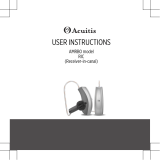 ACUITIS AMRB0 SY User guide
ACUITIS AMRB0 SY User guide
-
Vogue VXP E220 User guide
-
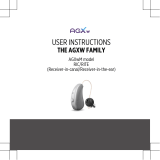 AUDIGY AGXwM MRR2D User guide
AUDIGY AGXwM MRR2D User guide
-
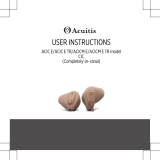 ACUITIS ACICM E PH User guide
ACUITIS ACICM E PH User guide
-
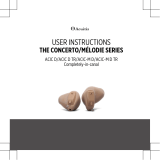 ACUITIS ACICM E PH Operating instructions
ACUITIS ACICM E PH Operating instructions
-
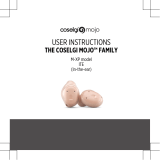 Coselgi Mojo M-XP M5 User guide
Coselgi Mojo M-XP M5 User guide
-
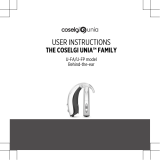 Coselgi Unia U-FA 4E User guide
Coselgi Unia U-FA 4E User guide
-
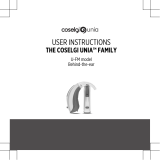 Coselgi UNIA U-FM 4 User guide
Coselgi UNIA U-FM 4 User guide
-
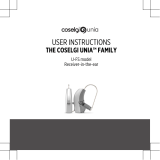 Coselgi UNIA U-FS User guide
Coselgi UNIA U-FS User guide
-
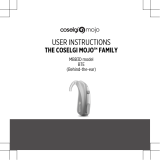 Coselgi Mojo MBB3D User guide
Coselgi Mojo MBB3D User guide
















































